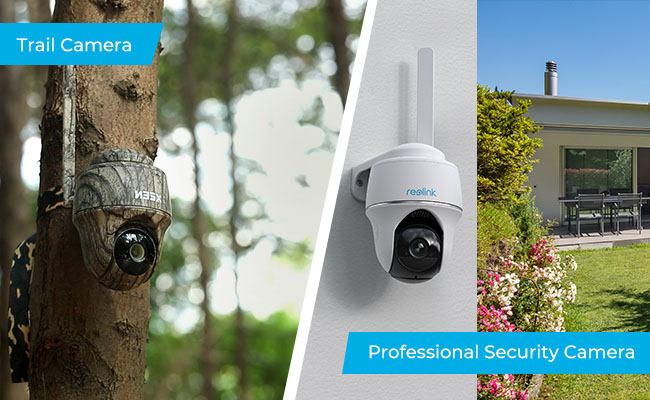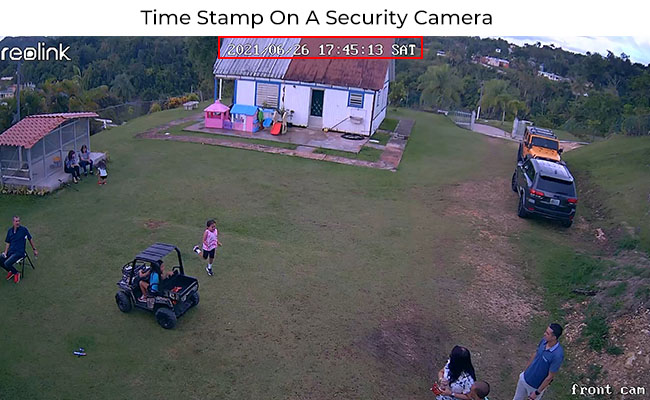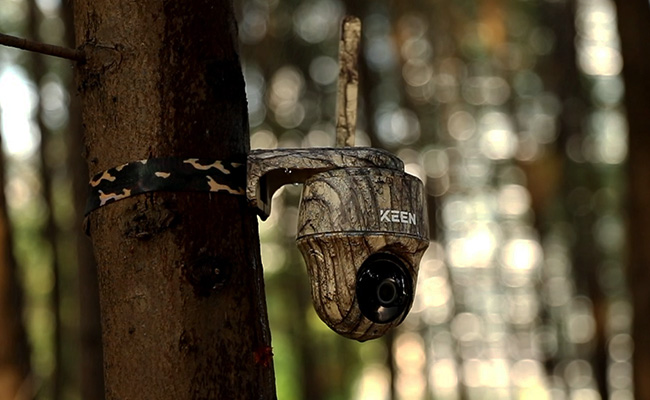Can You Use a Trail Cameras for Home Security?
The answer is YES, yes trail cameras can be used for home security, because trail cameras have basic features that make them suitable for home security surveillance.
Trail cameras or game cameras can capture suspicious activity near your property and alert you immediately. And because they run on batteries, they can be placed just about anywhere – even in remote areas where power outlets are unavailable.
Features that Make Trail Cameras Suitable for Home Security
Here are a few reasons why we think trail cameras are great for home security:
-
A trail camera’s Passive Infrared (PIR) sensor or heat sensor detects relative temperature changes or moving objects in an area, respectively. This feature is originally used to film animals in the field, but it is also efficient for capturing security footage.
-
Trail cameras have night vision, making them excellent for night security surveillance.
-
Most modern trail cameras now offer remote access to their feeds. An in-built cellular or Wi-Fi transceiver allows you to remotely download videos and photos to your phone/computer. The cellular trail camera has a SIM card, which is connected to a cell network. Plus, installation is easy and requires no wires.
-
Since they are battery-powered, trail cameras do not affect your energy bills. They can be set up in places where it’s not easy to run lines, like in a tree or on top of a shed roof! You won’t have to worry about replacing its batteries either; they can last for months.
Drawbacks of Trail Cameras
The benefits of a trail camera for home security are undeniable. They can provide an extra layer of protection for your home, and some of them may be less expensive than professional security cameras. But they do have some drawbacks, so let’s take a look at them.
-
They are not suitable for indoor use. Trail cams are square blocks with camouflage army colours and do not match most indoor decor styles. However, other home security cameras are white and have cute shapes.
-
Another drawback is that they don’t have pan/tilt functionality due to their fixed lenses. Although they take larger, clearer pictures, they often miss things in the surrounding background. Pan/tilt cameras are great for home security because they offer more flexibility when positioning them around your property.
-
A third disadvantage is that AA batteries in trail cameras don’t last very long when recording videos, so you’ll probably need to keep an eye on their charge levels and replace them regularly (or make sure you have backup batteries).
-
Finally, their mobile/desktop apps offer limited function compared to professional security camera apps that provide more features for monitoring your home’s activity.
Trail Camera vs. Security Camera
How is a Security Camera Different from a Trail Camera?
 There are a couple of differences between both camera types. An obvious one is their purpose – trail cams are made to track wildlife, while security cams are for security and surveillance. Another major difference is that security cameras can relay 24-hour video feeds, while trail cameras only take pictures and short videos when they detect a presence.
There are a couple of differences between both camera types. An obvious one is their purpose – trail cams are made to track wildlife, while security cams are for security and surveillance. Another major difference is that security cameras can relay 24-hour video feeds, while trail cameras only take pictures and short videos when they detect a presence.
A professional security camera is usually much more obvious than a trail camera, and sometimes that’s what you want when protecting your home. A visible security camera is a preventative measure and can deter criminals from making any moves on your property.
Professional security cameras also have a vast selection of features: they can be pan/tilt and zoom cameras, they can be powered via network cables with Power over Ethernet (POE), and they can even link up through an NVR (network video recorder) system so you can monitor multiple cameras at once.
What is a wildlife camera?
The wildlife camera, or trail camera, is a device designed for filming and photographing animals outdoors. When an animal passes by, it begins filming or photographing immediately. In some models, you can download the files wirelessly over Wi-Fi, while others allow you to save the images to a memory card that can be inserted into your computer.
Professional advice
If you’ve already bought your trail camera and want to use it for security surveillance, then we’d say go for it! You can definitely use a trail camera for home security.
However, if you need a camera for security purposes, we recommend you go with actual security cameras since they are specialized for that purpose.
If you’re looking for a professional security camera, we’ve got you covered. Our cameras offer many features you can choose from, including 4G connectivity, various sizes, PTZ functionality, Wi-Fi and wireless capabilities. These features are what make the difference between a good camera and an outstanding one.
A professional security camera is made to be used in a professional setting like an office or retail store. It’s designed with durability in mind so that it can stand up to the elements and rigours of daily use.
Set Up a Trail Camera for Security Surveillance
If you’re looking to use a trail camera as part of your home security system, there are some things you can do to make sure you’re doing it right.
 Before you get started, check that your camera has time stamps on it. Time stamps help you track the occurrence of activities on your property. They are also vital if you want to use the footage as evidence against a trespasser.
Before you get started, check that your camera has time stamps on it. Time stamps help you track the occurrence of activities on your property. They are also vital if you want to use the footage as evidence against a trespasser.
Once you’ve installed the camera, test it to ensure everything is working correctly. You don’t want to discover that the camera doesn’t work when it’s too late. Plus, if something goes wrong with your system, having a backup for when things don’t go according to plan is essential.
Making your trail camera conspicuous or not depends on you. If you want it hidden, try fixing it someplace where people won’t look twice at it — this way, they won’t suspect anything walking through your yard or doing suspicious stuff.
How do you hide a trail camera for home security?
 The best way to hide a trail camera is by placing it where nobody will see it. You want to make sure that it doesn’t look out of place or get in anyone’s way. Here are some ideas:
The best way to hide a trail camera is by placing it where nobody will see it. You want to make sure that it doesn’t look out of place or get in anyone’s way. Here are some ideas:
-
Put it in the shade: One option is to place your trail camera in a dark corner or shadowed area of your yard. If you have any trees in the area, they may be even better options because they will provide cover while also giving you a clear view of the area around your house.
-
Make it blend with the surroundings: Consider painting your camera in similar colours to its surroundings so that it blends right in. You can also try to camouflage it with natural foliage.
-
Fix it above eye level: Since people are less likely to look above their heads while walking, hanging your camera above eye level improves its chances of going unnoticed. Remember to fix the camera at an angle where it can see below it, though.
-
Use the environment as a disguise: You can hide the trail cameras in birdboxes, tree stumps and even fake rocks to keep it inconspicuous.
What to Look for When Picking a Trail Camera
If you’re looking for a trail camera for home security, there are a few things to consider.
-
Resolution: A higher resolution means the images will be clearer. This is especially important if you plan on using the camera for surveillance purposes.
-
Detection range: This typically ranges between 20 and 120 feet, but always confirm that the trail cam range is sufficient for your needs.
-
SD card support for local storage: If you want to store images locally instead of on an internet cloud, make sure the camera supports SD cards. You also have to check the maximum SD card memory capacity the camera can support, depending on what you need it for.
-
4G/Wi-Fi connectivity: This allows you to remotely access videos and pictures from your camera, as long as there is a phone signal.
-
Trigger-time: Trigger time refers to the time that passes between when the camera detects movement and when it takes a picture. Anything shorter than one second is ideal for your needs.
-
Light options: Trail cameras can either be no-glow or low-glow. Low-glow cameras emit a barely visible light before capturing footage. No-glow cameras, on the other hand, emit invisible light, making them less detectible, especially at night.
Final Thoughts
There is nothing wrong with using trail cameras for security purposes – they actually do an okay job of it. So, you can go ahead and repurpose your game camera for home surveillance.
But if you really mean business about setting up a security surveillance system, you can’t go wrong with professional security cameras. After all, that is specifically what they are designed for, and they have features that make them efficient at it.
Trail cameras are becoming increasingly popular, as they offer a convenient way to check on wildlife activity without having to physically be present in the area. Reolink’s KEEN Ranger PT is a recently released trail camera that offers 4G network connection and PT function. I hope you will find it to be a valuable addition to your trail camera arsenal. Thanks for reading!











































